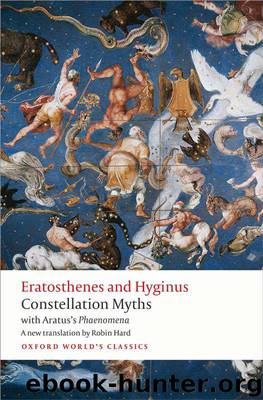Constellation Myths: with Aratus's Phaenomena (Oxford World's Classics) by Eratosthenes & Hyginus & Aratus

Author:Eratosthenes & Hyginus & Aratus
Language: eng
Format: mobi, epub
Publisher: OUP Oxford
Published: 2015-05-13T20:00:00+00:00
The Hyades
(i) A connection with Dionysos was suggested by the god’s cultic title of Hues. He was a son of Zeus by the Theban princess Semele, daughter of Cadmos, and was born in peculiar circumstances, because his father stitched him into his thigh after inadvertently causing the death of his pregnant mother, and brought him to birth in due time from his own body (see Ap. 3.4.3); there were two main traditions about what happened to him next, that he was reared either by nymphs or by his mother’s sister, Ino, at Thebes, but the two versions could be combined as in Hyginus’s narrative. The Hyades are identified there as the nymphs who were initially charged with his care, but these nymphs are said to have handed him over to Ino at some point (presumably because they and the child were coming under threat from the jealous Hera; the Lycourgos story is inserted from another source). The Hyades were already personified as nymphs in the Hesiodic Astronomy (fr. 219 MW), which cited five names for them, but it was the early mythographer Pherecydes (fifth century) who developed this story in which they were identified as the Dodonian nymphs who looked after the infant Dionysos; Pherecydes took over the Hesiodic names with additions and an alteration, so that there were now seven. The number of the Hyades varies from two to seven in different sources. A reference to the Dodonian nymphs in the Vatican Fragments confirms that Eratosthenes took over the story from Pherecydes. Dodona was in Epirus in north-western Greece, far away from Ino’s home-city of Thebes.
(ii) In a joint myth with the Pleiades, they and the Hyades are sisters, and they have a brother Hyas, who was invented to provide an explanation for the name of the Hyades. The sisters became divided into two groups, and so acquired their separate names, as a result of the differing degrees of grief that they felt when Hyas met a premature death during a hunting-trip. Five died quickly of their grief, and so came to be named the Hyades after their brother, while seven died more slowly, and were called the Pleiades because there were more of them ( pleious). There is an error in the present text of Hyginus’s Astronomy, which states that there were fifteen sisters rather than twelve, and then compounds the error with an idiocy through the explanation that it offers for the name of the Pleiades, by presenting them as having formed the more sensitive majority within the second group; since the correct number is given for the sisters in Hyginus’s other reference to the myth, in Fabulae 192, also translated above, the author himself may not have been responsible for this.
(iii) These are the daughters of Cadmos (schol. Arat. 172). There were four of these in the usual tradition, Agave and Autonoe being named in addition to Semele and Ino. Although no details are offered in our source, they were evidently placed in the sky because
Download
Constellation Myths: with Aratus's Phaenomena (Oxford World's Classics) by Eratosthenes & Hyginus & Aratus.epub
This site does not store any files on its server. We only index and link to content provided by other sites. Please contact the content providers to delete copyright contents if any and email us, we'll remove relevant links or contents immediately.
Letters From a Stoic by Seneca(2737)
The Valmiki Ramayana: Vol. 1 by Bibek Debroy(2383)
The Valmiki Ramayana: Vol. 2 by Bibek Debroy(2247)
The Valmiki Ramayana: Vol. 3 by Bibek Debroy(2146)
Mary Boleyn by Alison Weir(1849)
The Greeks by H. D. F. Kitto(1712)
The Notebooks of Leonardo Da Vinci by Da Vinci Leonardo(1569)
The Classics by Mary Beard(1545)
Mythos (2019 Re-Issue) by Stephen Fry(1519)
The Voynich Manuscript by Gerry Kennedy(1447)
Medea and Other Plays by Euripides(1403)
Art of Living by Sellars John;(1401)
Annals by Tacitus(1380)
Hindoo Holiday by J. R. Ackerley(1315)
Claudius the God by Robert Graves(1267)
Appeasement of Radhika by Muddupalani(1244)
Atlantis the Lost Continent Finally Found by Arysio Santos(1220)
Kadambari: Bana by Bana(1209)
THE REPUBLIC by plato(1208)
